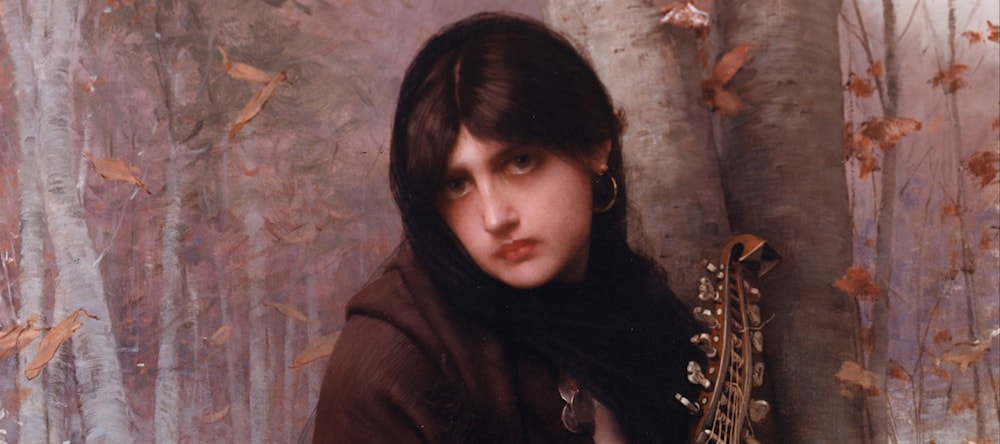Jules Joseph Lefebvre
Jules Joseph Lefebvre
76 artworks
French Academic Classical painter
Born 3/14/1836 - Died 2/24/1911

{"Id":188,"Name":"Jules Joseph Lefebvre","Biography":"A reviewer at the 1881 Paris \u003Ca href=\u0022http://www.bartleby.com/65/sa/Salon.html\u0022 target=\u0022_blank\u0022 class=\u0022link\u0022\u003ESalon\u003C/a\u003E wrote the following about Jules-Joseph Lef\u0026egrave;bvre: \u0026ldquo;It is sufficient to just mention his name in order to immediately evoke the memory and the image of the thousand adorable creatures of which he is the father.... Jules Lef\u0026egrave;bvre, better than anyone else caresses, with a brush both delicate and sure, the undulating contour of the feminine form.\u0026rdquo;\u003Ca href=\u0022#1\u0022\u003E[1]\u003C/a\u003E\u003Cbr\u003E\u003Cbr\u003ELike a typical academic artist, Lef\u0026egrave;bvre started his career with the traditional subject matter of histories and other narratives. It would not be till later in his career that he would focus exclusively on the human figure in portraiture and especially the female nude, with great ability and success.\u003Cbr\u003E\u003Cbr\u003ELef\u0026egrave;bvre was born on March 14th, 1836. Though his father was only a baker, he nonetheless encouraged his son to pursue painting, sending him to study in Paris in 1852. There, Lef\u0026egrave;bvre became a pupil of \u003Ca href=\u0022/asp/database/art.asp?aid=1721\u0022 target=\u0022_blank\u0022 class=\u0022link\u0022\u003EL\u0026eacute;on Cogniet\u003C/a\u003E and a year later started attending the \u003Ca href=\u0022http://www.bartleby.com/65/ec/Ecoledes.html\u0022 target=\u0022_blank\u0022 class=\u0022link\u0022\u003E\u0026Eacute;cole des Beaux Arts\u003C/a\u003E. His debut at the Paris Salon was in 1855. He then spent the next few years pursuing the coveted \u003Ca href=\u0022http://www.bartleby.com/65/pr/PrixdeRo.html\u0022 target=\u0022_blank\u0022 class=\u0022link\u0022\u003EPrix de Rome\u003C/a\u003E (the main competition for young painters, which would win him five years of study in Rome and a reputation that would all but guarantee a successful career). In 1859 he came close, placing second. Two years later the history painting \u003Cu\u003EThe Death of Priam\u003C/u\u003E would win him first place.\u003Cbr\u003E\u003Cbr\u003EIt would be during his stay in Rome that he would find his individual artistic niche. Able to study the great Italian masters, Lef\u0026egrave;bvre was fascinated by the Mannerist painters, especially \u003Ca href=\u0022/asp/database/art.asp?aid=237\u0022 target=\u0022_blank\u0022 class=\u0022link\u0022\u003EAndrea del Sarto\u003C/a\u003E. He copied his work avidly and demonstrated Andrea\u0026rsquo;s influence in his painting \u003Cu\u003EBoy Painting a Tragic Mask\u003C/u\u003E (1863)\u003Ca href=\u0022#2\u0022\u003E[2]\u003C/a\u003E. It was also during this time that his interest in the female nude began, painting his first in 1863. Among other works he did in Rome, he sent the narrative \u003Cu\u003ERoman Charity\u003C/u\u003E to the salon of 1864 and painted \u003Cu\u003ECornelia, Mother of the Gracchi\u003C/u\u003E in 1866. The latter narrative, however, was ill received by experts, arousing overwhelming criticism. That same year his parents and one of his sisters died. These negative events in both his personal and professional life sent him into severe depression.\u003Ca href=\u0022#2\u0022\u003E[2]\u003C/a\u003E\u003Cbr\u003E\u003Cbr\u003EHe emerged from his depression and came back to Paris with a different approach to art and a change of interest in subject matter. He apparently became disenchanted with the traditional formulaic approach to painting, instead turning towards more precise rendering from life.\u003Ca href=\u0022#2\u0022\u003E[2]\u003C/a\u003E In 1868 he exhibited a \u003Cu\u003EReclining Nude\u003C/u\u003E at the Salon, which unlike his last significant work, won him much praise.\u003Ca href=\u0022#2\u0022\u003E[2]\u003C/a\u003E Two years later, his allegory of \u003Cu\u003ETruth\u003C/u\u003E became his first great success.\u003Ca href=\u0022#1\u0022\u003E[1]\u003C/a\u003E A beautiful young woman holds up a mirror (the conventional symbol of truth). This symbol, though, is at the very top of the painting, so, in order to get to it one\u0026rsquo;s eye has to caress the sensuous feminine curves over the length of the outstretched figure. Shortly after the success of this nude, he was made an officer in the \u003Ca href=\u0022http://www.frenchculture.org/people/texts/honor.html\u0022 target=\u0022_blank\u0022 class=\u0022link\u0022\u003ELegion of Honor\u003C/a\u003E.\u003Cbr\u003E\u003Cbr\u003EWhat followed in the decades to come were variations on \u003Cu\u003ETruth\u003C/u\u003E. His many beautiful nudes took the roles of \u003Cu\u003EMary Magdalene\u003C/u\u003E (1876), \u003Cu\u003EPandora\u003C/u\u003E (1877), \u003Cu\u003EDiana\u003C/u\u003E (1879), \u003Cu\u003EPsyche\u003C/u\u003E (1883), and \u003Cu\u003EAurora\u003C/u\u003E among others. His nudes became so famous that his only rival was considered to be \u003Ca href=\u0022/asp/database/art.asp?aid=7\u0022 target=\u0022_blank\u0022 class=\u0022link\u0022\u003EBouguereau\u003C/a\u003E. Unlike Bouguereau\u0026rsquo;s figures though, Lef\u0026eacute;bvre used a greater variety of models, which can be seen in his work.\u003Cbr\u003E\u003Cbr\u003EIt is not surprising then that he exhibited seventy-two portraits at the Paris Salon from 1855 to 1898. Most, of course, are of women. Among those who sat for him include his daughter Yvonne, the Imperial Prince in 1874, and the novelist \u003Ca href=\u0022http://www.phatnav.com/wiki/wiki.phtml?title=Alexandre_Dumas%2C_fils\u0022 target=\u0022_blank\u0022 class=\u0022link\u0022\u003EAlexandre Dumas\u003C/a\u003E (1869), who also seems to have admired his nudes, purchasing a \u003Cu\u003EFemme Nue\u003C/u\u003E in 1892.\u003Cbr\u003E\u003Cbr\u003EIn the 1870\u0026rsquo;s he became a teacher at the Academie Julien (an atelier that trained women artists as well as men over a decade before they were also permitted into L\u0026rsquo;\u0026Eacute;cole des Beaux Arts). There he is said to have insisted to his students on absolute precision in life drawing.\u003Ca href=\u0022#3\u0022\u003E[3]\u003C/a\u003E There he became the most admired and sought after teacher of American ex-patriots, who came to Paris to study. Among his most famous American students, were \u003Ca href=\u0022/asp/database/art.asp?aid=864\u0022 target=\u0022_blank\u0022 class=\u0022link\u0022\u003EChild Hassam\u003C/a\u003E, \u003Ca href=\u0022/asp/database/art.asp?aid=309\u0022 target=\u0022_blank\u0022 class=\u0022link\u0022\u003EFrank Benson\u003C/a\u003E and \u003Ca href=\u0022/asp/database/art.asp?aid=559\u0022 target=\u0022_blank\u0022 class=\u0022link\u0022\u003EEdmund Tarbell\u003C/a\u003E\u003Ca href=\u0022#5\u0022\u003E[5]\u003C/a\u003E.\u003Cbr\u003E\u003Cbr\u003EFollowing the success of \u003Cu\u003ETruth\u003C/u\u003E, his accolades kept accumulating. Having won increasingly significant acclaim at the Universal Expositions, he ended up winning the grand prize in 1889. In 1891, he was made a member of the \u003Ca href=\u0022http://www.newadvent.org/cathen/01089a.htm\u0022 target=\u0022_blank\u0022 class=\u0022link\u0022\u003EAcademie des Beaux Arts\u003C/a\u003E. And in 1898, he was promoted to Commander in the Legion of Honor.\u003Cbr\u003E\u003Cbr\u003EWhat was admired then about Lef\u0026egrave;bvre, and can be admired today is the idealized realism of his figures. His \u0026ldquo;thousand adorable creatures\u0026rdquo; are beautiful yet individualized.\u003Cbr\u003E\u003Cbr\u003EJules Lef\u0026egrave;bvre died on February 24th 1911.\u003Cbr\u003E\u003Cbr\u003E\u003Cstrong\u003EBibliography:\u003C/strong\u003E\u003Cbr\u003E\u003Ca name=\u00221\u0022\u003E\u003C/a\u003E1.\u0026nbsp;\u0026nbsp;\u0026nbsp;\u0026nbsp;\u003Cu\u003EFrench Salon Artists from Southern Collections\u003C/u\u003E, Eric M. Zafron. High Museum of Art, Atlanta, 1982. (quote from L. Enault, Paris Salon, 1881)\u003Cbr\u003E\u003Ca name=\u00222\u0022\u003E\u003C/a\u003E2.\u0026nbsp;\u0026nbsp;\u0026nbsp;\u0026nbsp;\u003Cu\u003EThe Dictionary of Art\u003C/u\u003E, Jane Turner (editor). Groves Dictionary Inc., New York, 1996.\u003Cbr\u003E\u003Ca name=\u00223\u0022\u003E\u003C/a\u003E3.\u0026nbsp;\u0026nbsp;\u0026nbsp;\u0026nbsp;\u003Cu\u003EAlgemeines Lexikon der Bildenden Kunstler\u003C/u\u003E, Hans Vollmer (editor). E.A. Seeman, Leipzig, 1928.\u003Cbr\u003E\u003Ca name=\u00224\u0022\u003E\u003C/a\u003E4.\u0026nbsp;\u0026nbsp;\u0026nbsp;\u0026nbsp;\u003Cu\u003EArtists of the Nineteenth Century and their Works\u003C/u\u003E, Clara Erskine Clement and Lawrence Hutton. North Point Inc., St. Louis, 1969 (first published in 1879).\u003Cbr\u003E\u003Ca name=\u00225\u0022\u003E\u003C/a\u003E5.\u0026nbsp;\u0026nbsp;\u0026nbsp;\u0026nbsp;\u003Cu\u003EDictionaire Critique et Documentaire de Peintres, Sculpteurs, Dessinateurs, et Graveurs, E. Benezit\u003C/u\u003E. Librairie Grund, 1976 (first edition 1911).\u003Cp\u003E","BiographicalImageUrl":null,"StartYear":1836,"EndYear":1911,"Awards":null,"HasAlbums":false,"HasPortraits":true,"HasRelationships":true,"HasArticles":false,"HasDepictedPlaces":false,"HasLetters":true,"HasLibraryItems":false,"HasProducts":false,"HasSignatures":false,"HasVideos":false,"HasMapLocations":true,"TotalArtworks":76}


